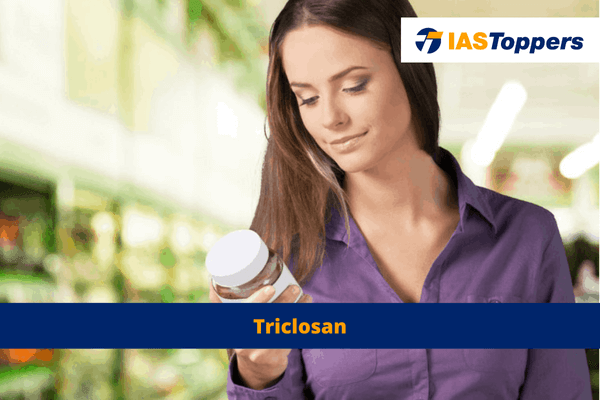Triclosan (TCS) is a widely used antimicrobial or antibacterial or antifungal agent that can be found in many consumer goods and personal care products. In this article, you will learn definition, uses and effects, how triclosan works, disadvantages, etc.
This article will provide key insights for GS Paper-III Science and technology section of UPSC IAS Exam.
Table of Content
- What is Triclosan?
- Properties of Triclosan
- How does triclosan kill bacteria?
- What is triclosan found in?
- Side effects of Triclosan
- Conclusion
- Frequently Asked Questions
- Reference
What is Triclosan?
- It is a substance included in items to minimize or stop the growth of bacteria.
- It solution was originally used in hospitals in 1972.
- Its other names are- Irgasan DP-300, Lexol 300, Ster-Zac, Cloxifenolum

Properties of Triclosan
- It is an organic compound existing as a white powdered solid with a slight aromatic or phenolic odor.
- It is categorized as a polychloro phenoxy phenol.
- It is a chlorinated aromatic compound that has functional groups representative of both ethers and phenols.
- It is soluble in ethanol, methanol, diethyl ether.
- It is similar in its uses and method of action to triclocarban.
- It has a residual effect inferior than chlorhexidine in terms of killing microbes.
How does triclosan kill bacteria?
- Triclosan binds to bacteria’s Enoyl-Acyl Carrier Protein Reductase (ENR) enzyme which then increases the enzyme’s affinity for Nicotinamide Adenine Dinucleotide (NAD+).
- This blocks the synthesis of fatty acid, which is necessary for bacterial growth.
- Humans do not have an ENR enzyme and thus are not affected by this mode of action.
What is triclosan found in?
- TCS persists in many personal care items like toothpaste, mouthwash, hand sanitizer, and surgical soaps, pesticides and certain cosmetics often in high concentrations.
- It can also be found in clothing, kitchenware, furniture, cleaning supplies and toys.
- The antimicrobial active ingredient is added to slow or stop the growth of bacteria, fungi, and other microbes.
- It is used on conveyor belts, fire hoses, dye bath vats, or ice-making equipment as an antimicrobial in commercial, institutional, and industrial equipment uses.
- It is also used in the coatings for some surgical stitches.

Side effects of Triclosan
Human body:
- Exposure to Triclosan may occur via consumer products, human urine and water, animal, food products contaminated with it.
- Human skin and oral mucosa readily absorb Triclosan.
- Thisleads to its presence in various human tissues and fluids.
- Its exposure can lead to disruption in endocrine glands which then disrupts the flow of hormones in the body with reduction in thyroid hormones being the prominent one.
- Triclosan exposure could contribute to antibiotic resistance in bacteria.
- Long-term triclosan exposure may lead to the development of skin cancer or breast cancer.
- It may expose human body to high risk of food allergy or seasonal allergy.
- Its use during pregnancy may lead to harmful effects as it may pass to infant via milk and blood of nursing mothers.
Environment:
- It is toxic to aquatic bacteria and various types of algae.
- It thus affects the structure of algal communities, especially when wastewater is released in water bodies even after being treated.
- This then leads to decline of other organism in aquatic ecosystem as algae is a primary producer which is consumed by other organisms.
- This disrupts the food chain of aquatic ecosystems.
- As it favours anaerobic conditions found in soil and sediment and is resistant to microbes, it remains in undegraded in environment for long run.
Conclusion
The triclosan does not bioaccumulates in Human body which is one of its benefits. Also, it is found effective in preventing gingivitis when used in sodium fluoride-based toothpaste. Though many of the drawbacks or side effects of the chemical has not been proven, it is better that the government take appropriate step to control its use and regulate its production. India lacks any regulation that bans or controls its use. It is banned in many products of U.S. and regulated in rest of them.
Define triclosan.
Triclosan (TCS) is a widely used antimicrobial or antibacterial or antifungal agent that can be found in many consumer goods and personal care products.
Is triclosan carcinogenic?
Triclosan is carcinogen in nature and may cause skin cancer or breast cancer.
Where does triclosan come from?
Triclosan is present in personal care items like toothpaste, mouthwash, hand sanitizer, and surgical soaps, pesticides, certain cosmetics and many such products.
What is triclosan used for?
Triclosan acts as a disinfectant or antimicrobial agent that kills microbes like bacteria or fungi when its solution is applied on any item.
What are the dangers of triclosan?
Exposure to triclosan can lead to disruption in endocrine glands which then disrupts the flow of hormones in the Human body.
How does triclosan affect the environment?
Triclosan is toxic to aquatic bacteria and various types of algae, which then disrupts the food chain of aquatic ecosystem.
How long does triclosan stay in your system?
Triclosan does not have bioaccumulation property and may be removed from human body via excretion.
How is triclosan made?
Triclosan is produced when 1,4-dichloro-2-nitrobenzene (C6H3Cl2NO3) is reacted with 2,4-dichlorophenol (C6H3ClOH).
Is triclosan bactericidal or bacteriostatic?
Triclosan is bacteriostatic at low concentrations, but higher levels are bactericidal


